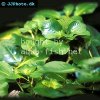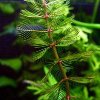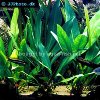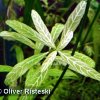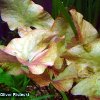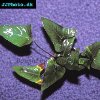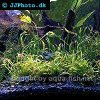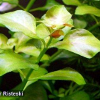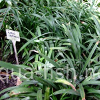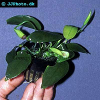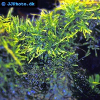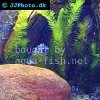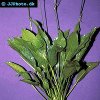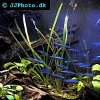Guide on Planting and Growing Aquarium Plants
Quick links - Answers
Brief Description
Nowadays many aquarists have decided to take a slightly different route with their tanks, rather than just use the tank to keep fish in with a few ornaments dotted about and the odd plant stuck in the corner, they are getting into the world of dedicating their tanks to a display of foliage where the plants are the main feature and any fish added are placed there for movement, taking second place to the greenery behind them.
Some keepers seem a bit daunted by this idea and are very reserved about taking the plunge but once this side hobby is taken on it is very rewarding and not as difficult to keep the plants healthy as many people think. More than often the hardest part is keeping the plants trimmed back when they are established, if this is not done on a regular basis, the tank will soon transform into a jungle unless slow growing species are specifically chosen. If you have decided to set up a planted tank then hopefully reading through this article will answer many of the questions you have yet to answer.
Starting off with a planted tank
The first thing to get right with your planted tank is the substrate that you are going to use, getting this right will ensure that the plants you add will be able to feed off the nutrients required to keep them healthy and have a good growth. Just adding plain gravel or sand may work in some tanks but eventually the food supply will run out and the plants will not be able to sustain the appropriate level of nutrients that they need, nowadays it is common practice to add a layer of specialised substrate below the gravel to act as a food source. There are many available to purchase from aquatic stores, some keepers will even add potting compost for this purpose, so do a little research and find out which is the best substrate for you.
Laterite is widely sold and is very good for this purpose but there are many more to choose from, many of the top companies like Tetra, JBL and Seachem produce purpose made media to use as the bottom substrate and are well worth looking at even though they may seem a bit pricey.
When your tank is cleaned and rinsed thoroughly add the plant substrate along the bottom of the tank to a depth of 2” (~5cm) (if using a larger tank the depth should be increased accordingly), this is your base layer, on top of this add another inch depth of fine gravel. The gravel that you decide to use is entirely your choice but I have always preferred to go for the 3mm fine gravel, this allows the roots to spread through quite quickly without them getting compacted. Sand is used by some planted tank keepers but this can clog the roots and I always try to avoid it.
Filtration for the tank is the next thing to be considered. You may be wondering why I didn’t mention this before we added the substrate to the tank, there is a reason for this. Some keepers are still using under gravel filters (UGF) in their tanks. This is not a god idea with a planted tank, in a short time the roots of the plants can easily clog up the plates on a UGF filter and render it useless, I would always suggest using a different method. Surprisingly the filtration in a planted tank tales a less important place in the table of musts than it does in a standard tropical fish tank. Because you are only going to add a few fish to the set up, less waste will be produced and if you get the balance right, the plants will convert the waste products to food for themselves, they definitely require some nitrates in the water so using a filter that is too efficient is actually detrimental to the health of the plants.
The main purposes of a filter in a planted tank are to remove any floating debris and keep your water clear, provide water circulation so that the nutrients and CO2 are spread evenly around the tank, and finally they will act as a host for some of the CO2 units available to buy (this will be discussed in detail further in the article).
Any commercial filter rated for your tank is fine but do not use one that is over rated and definitely do not add any nitrate remover or similar media to it.
To your tank add several inches of water carefully; placing a saucer or something similar over the substrate will prevent it from being displaced as you pour the water in. Generally speaking the water needs to be harder rather than softer as this means that it should have a good supply of trace elements locked in it for the plants to feed on. Do not fill the tank at this stage as this will make the planting a difficult job, only adding a few inches will mean that you can access the substrate easier. Set the heater to the required temperature and once the water has heated planting can begin.
Adding your plants
It is always advisable to draw a rough sketch of how your final planting should look and this will give you a plan to refer to while you are doing the actual planting. When you have plants laid out in front of you it is quite easy to lose track of which plants you are planting in which position.
Basically there are three types of plants:-
- Foreground plants - these tend to be the smaller species of plants that need to be at the front of the tank, they will spread, normally by runners and form a carpet of greenery.
- Mid ground plants - As the name suggests, these are planted in the middle of the tank, in front of the foreground plants as they will grow slightly taller but not too tall.
- Background plants - these are the tallest species of plants that need to go the rear of the tank, if placed at the front they would block out the view of the other plants that are in the tank.
There are many sites on the internet or books that will tell you exactly which plants you need as in their profiles the planting position will be added so that you can work out which plants are for the front or back of the tank.
There are several things to do before actually adding the plants to the tank.
- Always inspect the plants for snails and rinse them off, remove any dead leaves or cut off any decay or browning, if left on it will start to poison the water as it rots.
- When the plants have been removed from their protective packaging keep them moist, use a mister to keep giving them a spray every couple of minutes.
- Add all of your plants in one go, do not add a couple of plants every week or so, all of the nutrients will be consumed by your plants but if there are not enough in there, algae will start to feed from the tank and over run your plants.
- Use your finger or a pencil to create a depression in the substrate and carefully place your plant in there, cover over the roots with the substrate to anchor it down. Some cuttings etc. may refuse to stay down, in this case add a lead weight around the stem until the roots have established and then the weight can be removed. If the plant is a rhizome plant do not bury the rhizome below the substrate but leave the top exposed. Bulbs should also be planted in this manner; this will prevent the top of the bulb from rotting.
Lighting for a planted aquarium
All planted tanks will need a lighting system that is capable of promoting growth in the plants. Different species of plants will require different lighting levels always check with your supplier as to how much light the plant actually needs.
As a general rule the lighting unit should be 2-3 watt of lighting per gallon (~4.54 liter, ~1.20 US gallon) of water. Therefore if your tank is 50 gallons (~227 liter, ~60 US gallons) you will need 100 watts of lighting. Fluorescent lighting systems are the most commonly used especially with the high output T5 tubes that are now available but if you are using a deep tank it may be necessary to upgrade to more powerful systems like Metal Halide or mercury vapour lamps. If you are adding plants that require different lighting levels it is not as problem, plants with low lighting requirements can simply be planted directly in front of species that require more light, this way they will get shaded as the plants grow.
Here are some examples of plants that require different lighting levels:-
Low lighting
- Cryptocoryne, Vesicularia, Echinodorus
Medium lighting
- Sagittaria, Aponogeton, Bacopa
High lighting
Nutrients required by plants and adding them to the tank
As we have mentioned the plants will feed from nutrients in the water and from fish waste that has dispersed in the substrate but which nutrients are actually required. Below is a list of the required elements and what they actually do to benefit the plant.
- Carbon - This is the main food source for the plants, it provides energy in the form of sugars that are created in the process of photosynthesis.
- Nitrogen & Sulphur - These help in the process of protein synthesis where proteins are used for cell structural growth.
- Phosphorous - This helps the plant in the development of flowers.
- Iron - This helps in the development of chloroplast where photosynthesis occurs.
Other elements are required in small amounts; if these are given in large amounts they can affect the health of the plant. They are as follows: - copper, magnesium, zinc, and calcium.
These will all aid in the plant growth but do not need to be added to the tank as they are natural trace elements in water.
Feeding the plants is usually done by adding liquid fertilisers or tablets that are placed in the substrate. There are many brands available to purchase but always follow the directions as if they are overdosed it can affect your plants and fish. Rather than adding one weekly dose I have found it far better to divide the total dosage into daily amounts, as this keeps the water more stable and the required elements will never deplete.
Photosynthesis & CO2 units
Photosynthesis is the process where the plants convert CO2 gas and water into glucose for cell structure and plant growth. In the daytime the plants will absorb the carbon from the CO2 gas and the by product of this is oxygen released onto the water which will be beneficial to the fish. At night time as the lighting ceases, so does the photosynthesis and the plants will start to take oxygen from the water and produce CO2. Because of this the pH of the water will rise at night as more CO2 is concentrated in the water but this should drop again in the daytime as the whole process starts again.
To help the photosynthesis occur more rapidly which in turn will make the plants grow quicker, many planted tank keepers will add CO2 artificially with units that are added to the tank. There are three main types of these available.
CO2 bio-systems
These comprise of a container that holds varying amounts of yeast, sugar, and water. As the yeast ferments with the sugar, CO2 is produced and this is fed to the tank by means of tubing, the CO2 will then dissolve into the water. This is the cheapest option to use but it can be difficult to accurately see how much CO2 is being added to the tank.
CO2 mechanical system
This is a much more reliable system, the amount of CO2 added to the water can be controlled better and it is much more efficient. It uses a bottle of CO2 gas that has a regulator fitted with a needle valve and a bubble counter, the CO2 enters the tank with tubing that has a diffuser on the end. The amount of gas being used is controlled with the needle valve and the bubble counter gives you a visual reading of bubbles per minute so that the water does not get too concentrated with CO2 causing problems with the pH. Most of these units will have a solenoid fitted so that they automatically switch off at night when the plants no longer need the CO2.
CO2 electrolysis system
This is a high-tec unit that sends an electrical current into a carbon block causing it to release CO2 into the water. This unit can monitor its own output and the carbon block is easily replaced when it has been used.
With a planted tank the secret to running it successfully is to balance out the lighting and CO2 addition to get the most efficiency from the photosynthesis and to keep the nutrients in the water at a level where the plants have enough but not too much. One of the by products of getting this balance wrong is a mass onslaught of algae in the tank.
Often with an outbreak of algae keepers will rush out and buy a cure off the shelf without realising that these additives will also affect the health of the plants. It is far better to decrease the nutrients going in to the water or reduce the lighting hours to starve the algae out of the tank. Algae can feed from water that contains no nutrients if it is attached to a leaf of a plant that is having die back and the leaves are turning brown. This is why it is important to keep removing any brown or decaying leaves.
Preventing disease and poor health in the plants
Just like fish, plants can contract diseases and die off very quickly but there are preventative measures to eliminate this problem as much as possible.
- Never buy a plant that doesn’t look healthy.
- Sterilise your plants before adding them to the tank; this is easily done by dipping them in a solution of potassium permanganate for 10-15 minutes.
- Inspect your plants and remove any brown or decaying leaves before planting. When healthy plants are first introduced into the tank some leaves may die off; this is perfectly normal and the plants will recover.
There are other tell-tale signs that will tell you if your plants are not growing as they should be or are in poor health.
- Slender stalks and leaves dying off at the bottom of the plant is a sure sign of insufficient lighting, either try extending the lighting hours or invest in an additional lighting unit.
- Small brown spots or yellowing of the leaves will probably be due to the nitrates in the water being too high, increase the percentage of the water changes that are performed.
- Stunted growth, this is usually a deficiency of CO2 in the water, this is overcome by increasing the bubble rate on the CO2 unit and decreasing the aeration of the water.
- Small holes appearing in the leaves or on the edge of the leaves but the colour is still healthy looking, for this we can blame our little friends – the tank snails. The only way on ensuring that the snail population is kept to a minimum is to remove as many as you can see by hand and keep repeating the process.
Non-aquatic plants
Another common problem that a lot of keepers have is that there are a lot of non-aquatic plants being sold in the stores as suitable for aquariums. The sad result of this is that if they are added to the tank the end result will always be a dead plant that will decay and poison the water. The most common species that are definitely to be avoided are:-
- Aglaonema
- Brazilian swords
- Dracaena
- Mondo Grass
These will not survive being submerged for more than a month even though they are quite common in the pet stores as suitable.
Pruning and propagating
Once the plants are growing nicely in the tank, they will need cutting back to keep the growth at a maximum. Plants like the Amazon Swords will at some stage need the outer leaves removing to let the inner leaves grow out and the taller plants will need cutting back as they reach the water surface. If done on a regular basis this is not a chore but seeing the plants looking nice and neat should give some self satisfaction.
It is possible to multiply your plant collection by propagating your present plants which in turn will save you the expense of purchasing new ones. There are 5 main groups of propagating methods depending on the species of plant.
Cuttings
These are taken from bunch plants and it is the easiest method of propagation. Simply put, a length of the plant is cut away and the bottom leaves of the cutting are removed, the bare stem is then placed into the substrate at about 1” deep, this will then root itself to create a new plant.
Runners
Many of the plants will send out runners across the substrate and new shoots will grow from these. Weighting the runners down on the substrate will allow the new shoots to develop roots and then the runner stem can be cut away.
Rhizome
Rhizome plants always produce side shoots and by dividing the rhizome into several pieces, a number of new plants will be formed.
Adventitious plants
This is where young plants will grow out of the edges of the leaves of the mother plant. One well known species for this is Java Fern. Once the plantlets are large enough they will be released by the mother plant to settle elsewhere or they can be separated manually when large enough.
Seeds
Surprisingly many aquatic plants will produce flowers and propagate from seeds. A fine brush or a small paint brush is used to transfer the pollen to the different flower heads.
